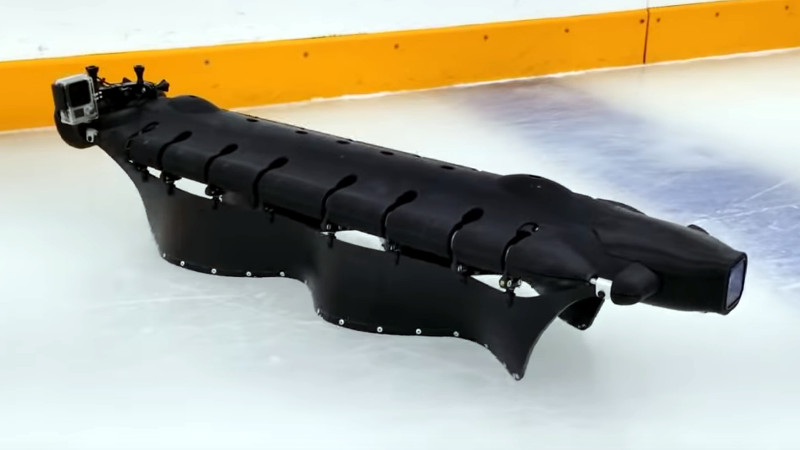You often hear that art imitates life, but sometimes technology does too. Pliant Energy Systems’ Velox robot resembles an underwater creature more than it does a robot because it uses undulating fins to propel itself, as you can see in the video below.
The video shows the beast skating, but also swimming, and walking. It really does look more like a lifeform than a device. According to the company, the robot has excellent static thrust/watt and is resistant to becoming entangled in plants and other debris.
The downside of this report is that it is sparse on technical detail. However, because there is mention of patents it was reasonably easy to find out more that way. From trying to decode the patent legal jargon, it looks like the key is the deformation of the flexible fin using a transducer (we would have said actuator) to bend the material. In other words, the plastic fin is “popped out” (or in) and the actuator pulls or pushes it out of shape and then lets it pop back to its original position. We think.
Although they do show it slithering across solid surfaces, we bet it would have trouble on anything that wasn’t reasonably flat or had a high coefficient of friction. It sure looks good in the water, though.
If you search for other patents the company holds, you’ll see that like a lot of things, you can operate the device in reverse and use it to extract power from moving liquids. That gives us a few ideas, too.
The drivetrain reminded us of the many snake robots we’ve seen. If you prefer to have something swim like we do, there’s the Swumanoid (the site is dead, but the video is still there).















When i see this thing move, i think both sea slug, and the Horta aliens from Star Trek.
Looks like they’re basically using servos to induce sine-waves in the fins, not rocket science but the programing is probably very complex to time the movements correctly
Or, just two motors, and a cleverly designed crankshaft.
Sometimes we get so wrapped up in the computer side that we completely forget about elegant mechanical solutions. :)
Add some soft tentacles and you’ll have a robotic cuttlefish!
Id rather hear more about their hydrokinetic generator…nifty! https://www.youtube.com/watch?v=b29bIqnXFW0
The other youtube video about it https://www.youtube.com/watch?v=JeSmxLhSI-o has an interesting comment. Id love for HAD to get in touch with Zlatko Rozic and see whats what with what.
that guys attitude really irks me.
apparently he’s been sitting on this tech for a lifetime but the only thing he’s done with it was commented on a youtube video about how great he is for making it. The only Liked video on his profile is: NASA Secret Project To Blow Up Planet Saturn? 2/1/17
quick patent search reveals that I don’t understand the Australian patent office — I could find info about the (expired) patent, but couldn’t fetch the document itself.
I don’t see anything about the efficiency of these things, and I’m not sure how they would compare to a screw.
That guy doesn’t seem to understand patents:
http://pericles.ipaustralia.gov.au/ols/auspat/applicationDetails.do?applicationNo=1995039123
Filing date: 1995-11-2
Australian OPI date: 1996-06-06
Effective date of patent: 1995-11-28
Expiry date: 2015-11-28 <<———————————
So there are several APPLICATIONS, all expired, the number he lists in the comment doesn't seem to be a valid Australian patent number. Some searching did turn up something in the WIPO database that might actually be a patent, but I can't find if it's still valid. Seeing as it was published 20 years ago, probably not.
https://patentscope.wipo.int/search/en/detail.jsf?docId=AU180671586&tab=PCTCLAIMS&office=&prevFilter=&sortOption=Pub+Date+Desc&queryString=FP%3A%28Zlatko+Rozic%29&recNum=2&maxRec=2
His claims and descriptions were clearly written by himself, with a "not so great" grasp of the english language probably further hampered by trying to speak patent-legaleze, without understanding the point.
In conclusion, his claims are vague enough and probably so full of holes the lawyers would have a field day tearing the patent to shreds if it ever came to court.
Sorry to say for the guy, but he probably spent a lot of money and will never see a dime for it.
The lesson here is: If you don't intend to immediately bring a product to market or aggressively market your patent for sale, don't bother getting a patent.
Any data on whether this performs better than something with 4 wheels and a propeller?
I know people are obsessed with reinventing the wheel but I’m pretty sceptical that a wheel isn’t the right answer 99.9% of the time.
not tangling itself in long plants would be a start…
Not to mention… how does a wheel help you out when you’re sitting in the middle of a body of water.
https://m.youtube.com/watch?v=ZoxlYrSO4m4
It’s a Rob-Anomalacaris (https://en.wikipedia.org/wiki/Anomalocaris) I want one, were is my 3d printer……
As for efficiency I would say good as nature hates to waist energy and the Anomalocaridids were around for sometime. That being said the Anomalocaridids “propulsion surface(?need better name)” was made up of segments and not a single flexible surface (that we know of) so there might be difference. Wonder if a segmented approach leads to better axis control…